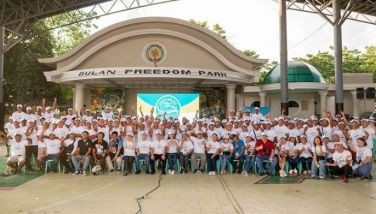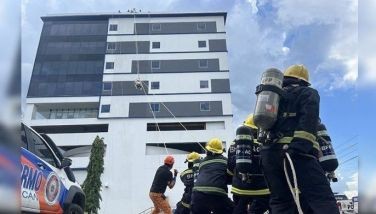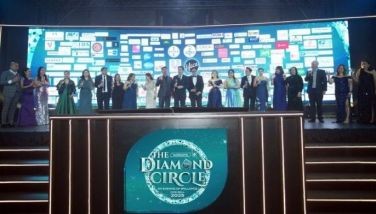What kind of city do you want?
Aweek from now Manny Pacquiao will meet his Mexican archrival Juan Manuel Marquez in the ring for the fourth time. Many believe that Marquez was the true winner of their last bout, which Pacquiao won by a split decision (and that Pacquiao was the winner of his fight against Bradley, the result of which seemed like a correction). Of all Pacquiao’s opponents it is Marquez who has been the greatest threat, if not the match for the Filipino champion. Will Marquez have his overdue victory, or will Pacquiao end all debate at last?
I won’t even venture a guess. However, I can tell you in all certainty that in the morning and early afternoon of Dec. 9, the streets of Metro Manila will enjoy very light traffic. There will be few cars on the road; everyone will be watching the boxing live from Vegas. It should be a good time to do your Christmas shopping. The only time city driving will be this pleasant is during Lent, when the residents go on vacation. As no one will listen to my suggestion that we barricade all access to Metro Manila (so they can’t come back in and we can de-congest the streets forever!!!), we can only hope that Pac-man goes on fighting. His matches offer us the rare reprieve from the daily hostage situation on the road.
Heavy traffic is such a fact of urban life, it seems pointless to complain about it. But we do bitch about traffic, if only to vent our frustration before it clogs our follicles and we go bald. In other cities traffic jams make headlines; in ours, light traffic is news. We assume that we have the worst traffic on earth. It’s almost a point of pride, so when we’re sitting in a snarl-up in Jakarta, LA or Paris and we say, “Parang Maynila,” it’s a kind of perverse compliment.
Recently we hung out with a couple of transport geeks who were in Manila for a traffic summit organized by the Asian Development Bank. Bernardo Baranda is director for Latin America and Michael Kodransky is global research manager of the Institute for Transportation and Development Policy (ITDP), a non-profit organization working for sustainable transportation development. As luck would have it, we landed right in their area of expertise: Friday night gridlock. We ended up talking about traffic with traffic policy consultants while sitting in traffic. (Is that meta?)
“I don’t think that Manila is worse than the emerging Indian cities or Bangkok or Sao Paulo, but I know that’s not a relief,” said Bernardo. “Most big cities in the developing world face similar transport-related problems: congestion, pollution, accidents.”
The old conventional wisdom was that economic vitality and traffic congestion went hand-in-hand, Michael noted. Traffic was regarded as a sign of progress. “Motorized countries made space for driving, while neglecting other modes of transport.” As today’s cities grapple with the consequences of traffic on productivity, environment and health, that way of thinking has undergone an overhaul.
Traffic costs cities billions of dollars. In Mexico City where Bernardo lives, the cost of congestion was estimated a few years ago at US$7 billion a year. Later Michael sent some stats: traffic congestion leads to $13 billion in annual costs to businesses and consumers, according to a 2006 report by the Partnership for New York City. Traffic congestion costs the European Union about $100 billion a year (one percent of GDP), based on a European Commission report.
What can we do? The ITDP guys suggested biking as the sustainable alternative to driving. I pointed out that in Manila it might be easier to invent a time machine that will send you three hours into the future (so you literally get ahead of the traffic) than to get people to ride bicycles. Assuming some people are willing to bike to and from work, they’d probably get black lung in no time.
“The bike is not the only solution, but certainly part of it,” Bernardo said. “Remember that the majority of urban trips are less than seven kilometers” — a distance that a bike can cover in less than 30 minutes. “It’s important to integrate urban planning with mass transit, and improve conditions for pedestrians and cyclists.”
Michael suggests upgrading existing public transportation and making it so high quality that upper-income citizens would also take public transportation. This would lead to fewer single-person private cars on the street.
Getting Manileños to leave their cars at home and take public transport seems even less likely than convincing them to ride bikes to work. Fine, I am a cynical urban dweller, but remember how the upper-income citizens dealt with the license plate number coding scheme for reducing traffic: they bought another car.
The transport geeks cited strategies that have worked in places like Bogota and Guangzhou and could also work in Manila. First, we would need a comprehensive and integrated strategy that prioritizes high-quality public transport. For instance, in one lane you could move 10,000 people per hour on a bus, as opposed to 500 cars. Lanes could be dedicated to high-occupancy vehicles, thereby dissuading single-person trips, and congestion charges collected during peak-use times (as in London, Singapore and Stockholm).
The new transportation secretary has mentioned plans for a Bus Rapid Transit (BRT) system — a solution implemented successfully in Bogota by former mayor Enrique Peñalosa, now president of the ITDP. A BRT system for Metro Manila was proposed as far back as the first Aquino administration — let’s see it happen.
Michael brought up reduced parking as a means of alleviating traffic congestion. In the 1970s, cities like New York and Boston froze their public parking supply to comply with air quality regulations from the US Environmental Protection Agency.
According to a study by University of Vienna professor Herman Knoflacher, inventor of the Walkmobile, people are less likely to use public transit when parking is available in their building. If people have to walk one block to reach the public transport stop, but they can get to their parking spaces without leaving the premises, there’s no competition. They will choose driving because of the convenience of accessing their cars. “That’s one reason why traffic is so bad in Manila,” Michael said. “The design of buildings and streets favor the car.” You can get to your car easily, but then the roads serve as bottlenecks.
Zurich, Tokyo, Hong Kong, Paris, London and other cities are improving access to destinations by providing better public transit, biking and walking infrastructure. “They demonstrate that you can still be economically successful without building lots of highways and providing more and more free/cheap parking,” Michael added. “Even Los Angeles, perhaps the birthplace of the traffic jam, with its inadequate high-quality public transit and sprawling land use, is doing a big rethink.”
There are creative methods for financing high-quality public transit. In Budapest, parking revenue is used to improve bus service frequency, then a big ad on the side of the bus lets the public know who paid for the improvement. (Aha, a useful variant on that classic means of political self-promotion, epal.)
In Barcelona, parking fees subsidize the bike sharing system, which has stimulated biking in the city. In Mexico City, the parking fees go to neighborhood improvement projects. “All these strategies are meant to get public buy-in,” Michael said. “The public can see where the money from higher-priced parking or roads goes to improve quality of life.”
In Zurich, developers must present the city with a mobility plan to show how they will divert driving trips to their site. Some offer public transit passes as part of the lease. “The ultimate issue is the kind of city citizens want,” Michael declared.
I want a city where each day actually consists of 24 hours and not just what’s left over from traffic. I want a city where pedestrians have sidewalks and are not merely road kill. I want a city with open public spaces and breathable air. I want a city where your ability to get around is not determined by how big and badass your ride is. I want a city designed for human beings and not fuel-burning cars.
Could this Metro Manila exist?
















